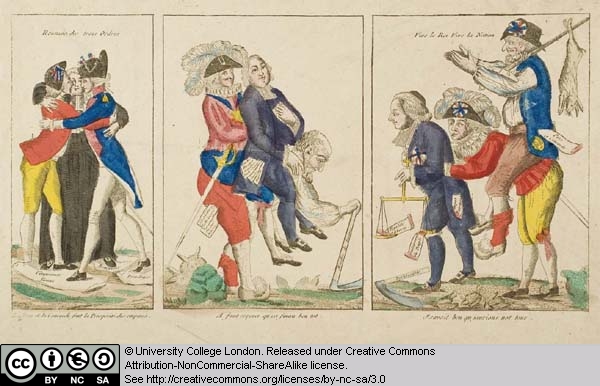1 Reunion de Trois Ordres

Anonymous
Réunion des trois
ordres (Reunion of the three estates), 1789
Etching with
hand-colouring
Publisher unrecorded
This print is in fact a combination of three etchings
produced separately during the summer of 1789 to celebrate the overthrow of the
political and social order in France
following the Bastille’s fall and the legislative events of the night of 4th August.
It seems probable that their juxtaposition by the publisher is not because they
naturally belong together (only the central and right-hand image were ever
paired as pendants, and they do not match the left-hand image visually or
intellectually). Rather, their montage might stem from the publisher’s belief
in their commercial potential: images of this type were extremely popular. The
colouring is quite crudely executed suggesting that the print would have been
intended for mass production and dissemination at a modest price.
The figures represented in each of the scenes are
embodiments of the Three Estates. The First Estate
(the clergy) is identifiable by his priestly garments and crucifix, the Second
Estate (the nobility) by his sword and extravagant attire, and the Third
(everyone else) by humble dress and the tools with which he tills the land. At
the time of the print’s production, artists sought ways of representing the
changing relationships between the orders in revolutionary France,
employing metaphors provided by music, food, dance, and children’s games to
help visualise essentially abstract ideas. In the central image A faut esperer
qu ca finira ben tot (I’ve got to hope that I’ll be done soon) the engraver has
chosen a backbreaking game of piggyback to allegorise the inequalities of the ancien
régime, depicting the character representing the Third Estate – a peasant –
single-handedly supporting the others through his labour. Bent double under the
weight of the burden, his hoe doubles up as a prop. In the right-hand image J
savait ben qu’jaurions not tour (I knew that we would soon have our turn) we
see the tables turned and the First and Second Estates subjected to the
treatment long endured by the Third, who is now carried aloft. The fact that he
has killed the birds and caught the rabbit that nibbled at his crops in the
central image (a reference to his new-found hunting rights, previously reserved
for the second estate) is another sign of his triumph. Clues found among their
dress and props inform the viewer that the coming of the Revolution can be
credited with this reversal in fortunes: all three wear the tricolour cockade
for instance.
Whereas the right-hand image gleefully showed the first two
Estates humiliated and subjugated, the image on the left La Paix et la Concorde
font la Prosperite des empires (Peace and harmony make empires prosper),
depicts equality between the three orders. Each of them step beyond their
prejudices and privileges (inscribed on papers beneath their feet) to unite in
a single unit. The caption above their heads simply reads ‘Réunion des trois
ordres’ ( Reunion of the three estates) . In
fact all three images contain much verbal material which helps convey the
print’s message in considerable detail, reducing the risk of misinterpretation
by its audience.
Licensed under the Creative Commons Attribution Non-commercial Share Alike 3.0 License
This resource has been released as an open educational resource (OER) on a Creative Commons 'Attribution Non-commercial Share Alike' license. This means that once downloaded, content can be modified and improved to complement a particular course. This requires, however, that improvements are recycled back into the OER community. All content present at the time of download must be accordingly credited and, in turn, novel content must be appropriately licensed.
